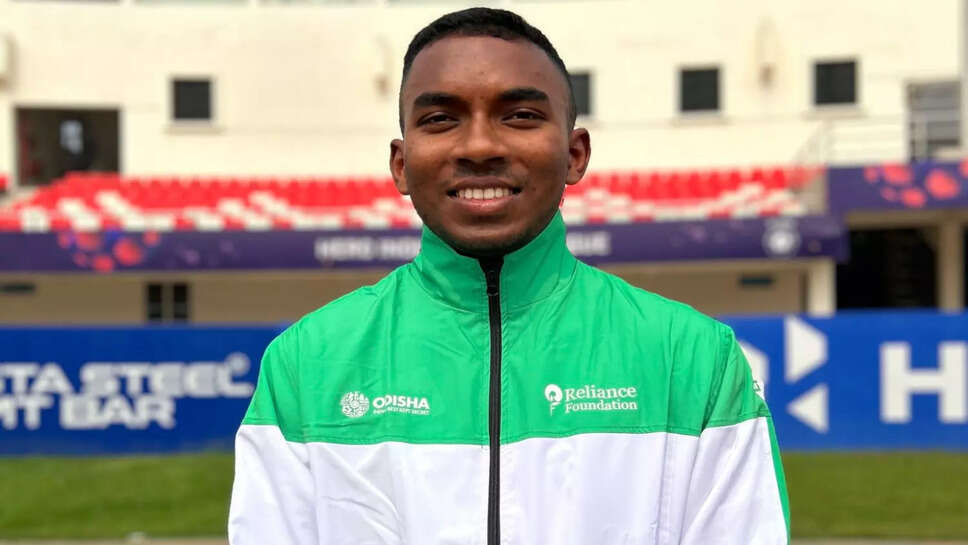Perfecting the Push-Off: Animesh Kujur’s Sprinting Evolution

Animesh Kujur stands silent at the starting block. His breathing is controlled, his muscles coiled, his gaze focused just ahead—not on the finish line, but the first step. In the world of elite sprinting, races are often won not in the final surge, but in the fraction of a second it takes to leave the blocks. And that is where India’s fastest man is reinventing himself.
In a sport where the difference between gold and forgotten can be 0.01 seconds, Kujur isn’t chasing just personal bests—he’s chasing perfection. With eyes on bigger podiums and grander stages, the 24-year-old is deconstructing his sprint—right from the very first movement.
The First Step: A Race Within the Race
“I had to restart everything,” Kujur says, reflecting on his post-Asian Championships assessment. “Everyone talks about top speed and endurance, but I realized I was losing time before the race had even really begun.”
His coaches agreed. Data from high-speed cameras and sprint analytics showed that while his top-end speed was elite, his reaction time and first 10 meters lagged behind international standards. For a sprinter competing in sub-10-second territory, that lag was a liability.
So, Animesh chose to tear down and rebuild—starting with the start.
Drilling the Basics
The new training regimen focuses obsessively on technique. From hip angles and shin placement to pressure exerted on the blocks, every micro-movement is measured, analyzed, and refined.
“We're teaching his body to react faster, lean smarter, and push harder—all in under 200 milliseconds,” says his coach. This includes early morning resisted sled sprints, start drills with weighted vests, and even shadow starts in front of mirrors.
Much like a pianist practicing scales or a dancer repeating pirouettes, Animesh now repeats the same 3-second movement hundreds of times a week.
The Science of Sprinting
Speed, it turns out, isn’t just about fast legs. It’s neuromuscular. It's about how quickly your brain tells your body to move and how efficiently the body complies. That’s where Kujur’s recent collaboration with sports scientists has made a difference.
He’s now undergoing reaction training using strobe lights, biomechanical video analysis, and EMG scans to map muscle activation. The goal is simple: optimize every movement, eliminate wasted energy, and create explosive efficiency.
And the results are starting to show. In his latest time trials, Kujur has shaved 0.04 seconds off his 0–10m split—a huge leap in elite sprinting terms.
Mind Games and Muscle Memory
Physical conditioning is only part of the puzzle. Much of Animesh’s transformation is mental. He’s working with a sports psychologist to enhance focus, confidence, and mental readiness during starts.
“I used to overthink in the blocks,” he admits. “Now, I visualize every detail—my hand tension, the starter’s gun, the exact feel of the turf on my spikes.”
Through guided visualization sessions, Kujur is building what he calls “muscle memory in the mind.” It’s a process elite sprinters like Usain Bolt have often credited for consistent starts under pressure.
Sprinting Against Time, and History
India has never been a sprinting powerhouse. While names like Milkha Singh and PT Usha gave the nation hope on the track, the 100m dash remained dominated by athletes from the Americas, Caribbean, and Africa. But Kujur’s emergence is shifting that narrative.
Clocking 10.18 seconds in the nationals and consistently breaching sub-10.25 across multiple meets, he has made the world take notice. Now, with a sharper start and bigger goals, the dream of India’s first sub-10 sprinter no longer seems far-fetched.
“Every millisecond I save at the start brings me closer to history,” he says.
Behind the Speed: A Routine Built on Discipline
Kujur’s typical day begins at 5 AM. His morning routine includes dynamic stretching, block drills, and acceleration work. Post-breakfast, it’s strength training with a focus on posterior chain development—glutes, hamstrings, and core.
Evenings are for tempo runs, recovery sessions, and mobility work. But the most significant addition to his training lately? Sleep. Eight to nine hours of uninterrupted rest is now non-negotiable.
“I used to think pushing harder meant more reps. Now I know smarter recovery gives better gains,” he says.
Inspiration and Influence
Though sprinting remains largely individual, Animesh credits his progress to a tight circle: his physio, psychologist, coach, and family. He also draws inspiration from global icons like Trayvon Bromell, Noah Lyles, and Fred Kerley, often breaking down their starts frame-by-frame.
Closer home, he’s become a role model for junior sprinters, especially in Jharkhand and Odisha—regions that have quietly produced a wealth of raw athletic talent.
What’s Next?
The short-term focus is the World Athletics Championships and Olympic qualifiers. Long-term? A sub-10-second timing on home soil.
“I want kids watching me on TV to believe that even Indians can dominate the 100 meters,” he says, eyes gleaming with purpose.
Kujur is also advocating for better infrastructure. “Talent we have. What we lack are synthetic tracks, timing systems, proper nutrition. If we fix that, we’ll produce more Animeshes.”
One Step at a Time, Toward Glory
It’s not often that athletes restart the most fundamental part of their sport mid-career. But Animesh Kujur is no ordinary athlete. He’s chasing milliseconds not out of obsession, but out of belief—that India can run faster, push harder, and maybe even stand shoulder-to-shoulder with the world’s sprinting elite.
So the next time you watch him explode from the blocks, remember: that first step is not just a beginning. It’s a revolution, one foot at a time.
.jpg)